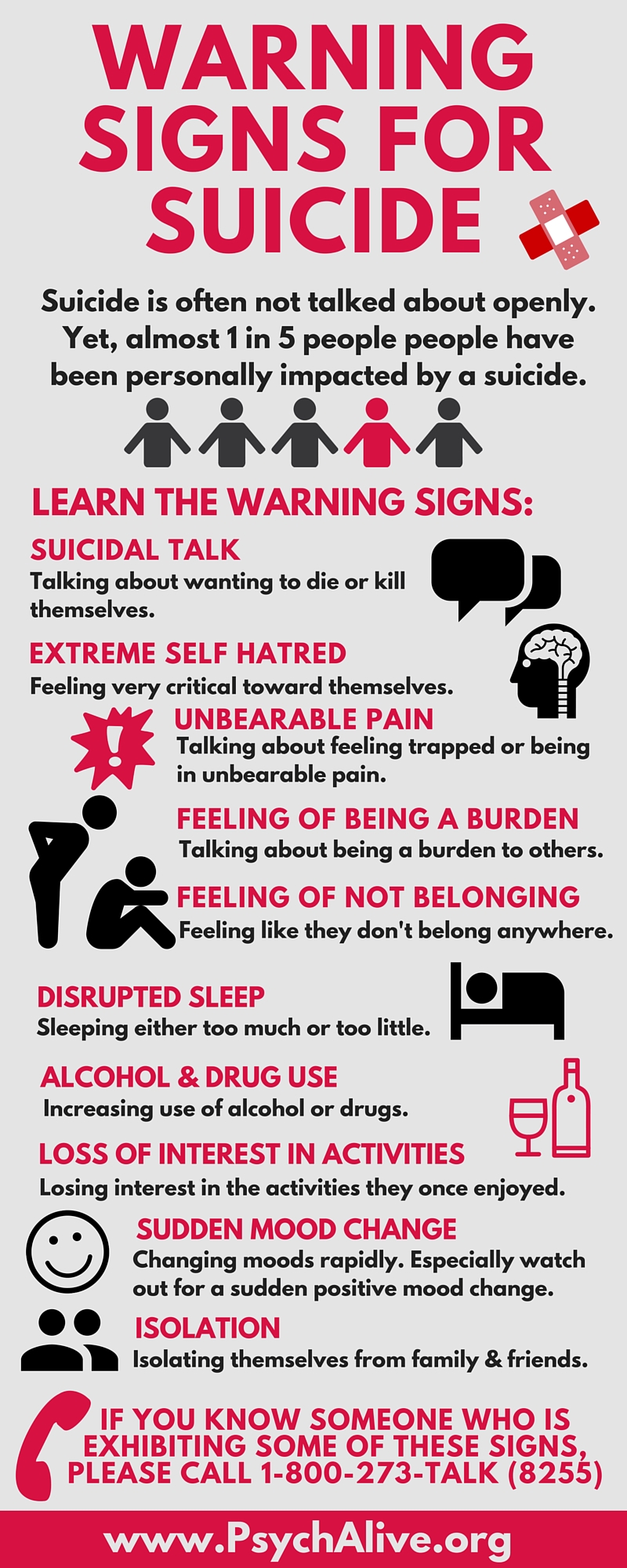How You Can Help Prevent a Suicide
 With better education and awareness about suicide prevention, lives can be saved.
With better education and awareness about suicide prevention, lives can be saved.
September’s National Suicide Prevention Month sheds light on a subject all too often avoided in our society. Suicide affects millions of people each year. Suicide is the tenth leading cause of death in the United States, according to the Centers for Disease Control. The first step toward stopping this devastating and preventable public health problem involves taking the topic out of the closet and facing it head on. With education and awareness, lives can be saved. September 10 is World Suicide Prevention Day. On this day, I will be hosting the free Webinar “Understanding and Preventing Suicide,” a one-hour online presentation that will illuminate both the warning signs and helper tasks for suicide that can help us save a life.
All of us can do our part to prevent suicide. Reaching out means first paying attention and noticing when people are showing signs that they could be at risk, and second, taking the time to let people know we care. Kevin Hines, who miraculously survived a suicide attempt jumping off the Golden Gate Bridge, later recounted that he paced the bridge for an hour, crying, hoping and praying that one person would ask him what was wrong. He said he would have told them everything. In a chilling diary entry, another person who died by suicide left the message that if one person smiled at him on his walk that day, he wouldn’t kill himself.
Though the consequences can be fatal, suicide is not a black or white issue. Suicidal people are often very ambivalent. They are experiencing an inner debate between a part of them that wants to live (their real self) and a part that wants to die (their anti-self). Reaching out and connecting with the part of them that wants to live can truly save a life.
When it comes to warning signs for suicide, we are much better off overreacting than under-reacting. If you notice that a friend isn’t herself (i.e. giving up interests, seeking isolation) or a family member is hinting at self-destructive behavior or saying things like “you would be better off without me,” you should take these warning signs seriously. Because suicidal individuals are almost always ambivalent, they often give signs letting people know they are in trouble. They may even hint at or admit that they’re contemplating hurting themselves, then take it back and deny that they’re in danger. Therefore, it is important that you take these signs seriously and help the person get to the help he or she needs.
We need to be proactive in offering assistance to individuals who we think might be considering suicide. You can start by recognizing some of the red flags that would indicate the person is in trouble. While there are long-term risk factors for suicide, there are also immediate warning signs that someone could be planning to take their own life. These include:
1) Trouble sleeping – How well you sleep represents your overall level of arousal. People who are suicidal are in an anxious over-activated state in which they are anxious and agitated, struggling with tolerating or regulating unbearable psychological pain. They are desperate for a solution. This can make it hard for them to sleep, which, in turn, exacerbates the difficulty they are experiencing trying to calm these feelings down.
2) Making preparations – Any actions people take toward ending their lives should be taken seriously. If a friend jokes that they’re going to kill themselves tomorrow, the threat should not be taken lightly. If they purchase a weapon or attain any dangerous substance, these are serious signs they could hurt themselves. If they’re giving away their possessions or saying goodbyes, these are true causes for alarm.
3) Sense of personalized hopelessness – If someone perceives their life or situation as hopeless, they may be at risk. Keep in mind what may seem hopeless to them may not appear hopeless to you. Try to see the crisis through their point of view, as they experience it.
4) Talking about suicide – Recent CDC statistics revealed that an estimated 8.3 million adults reported having suicidal thoughts in the past year, while an estimated 2.2 million adults made suicide plans. When people talk about suicide, it means it is on their mind, and they could be considering it.
5) Isolating themselves – Is the person creating distance between himself and other people? Does she spend time in isolation, retreating from friends or loved ones? Does he feel like he doesn’t belong? When people are alone, they are more likely to listen to their “critical inner voice” or “anti-self” and fall into a suicidal trance.
6) Perceived burdensomeness – When people start to think that others (their closest family and friends) are better off without them, they are at higher risk for suicide. If they feel like they are a burden to others, they may listen to this thought, rather than realize how much pain their loss would cause loved ones. People who lose loved ones to suicide face a difficult grieving process.
See a full list of warning signs for suicide.
When you suspect someone is in trouble, you can offer them support and assistance getting help. If you’re concerned, you should ask directly if they are having thoughts about suicide. Open up the subject, look them in the eye and show them you care and want to be there for them. You should do what you can to help the person feel safe and free to talk. You should be careful not to put the person off by trying to talk him or her out of it. Instead, you should really listen and try to hear what people in crisis are feeling. What is the present crisis as they see it? You should reflect back to them what you are hearing to show that you really want to understand. As you get them talking, you also want to look for signs of the part of them that wants to live You can ask them what has made them feel better in the past and offer to help them try those things now. You can take a walk with them or just sit and breathe together, anything that will help them start to calm down. This might mean just sitting and being with them in their pain. It is important not to leave them alone.
See a full list of helper tasks to prevent suicide.
If you want guidance on how to help someone, or if you are in trouble yourself, you can always call the National Suicide Prevention Lifeline, a free hotline available 24/7. Lifeline also offers an online chat feature on their website and now has e-cards that you can send to people you’re concerned about. You can seek out a local therapist to treat the person in crisis or to advise you. If the person is in immediate danger, you can call 911 or take them to the Emergency Room at any hospital. If they’re on a college campus, you can escort them to the counseling center. You can be an essential link to them getting the help they need. You should always follow up with the person to make sure they’re okay and to let them know you care about them staying alive.
Too often, suicide may seem like something we can do nothing about, but this is rarely true. What we’ve learned in the field of suicide prevention is that what helps suicidal people stay alive is learning the skills that help them through a suicidal crisis. One of the most important findings has been that people can learn the skills to whether crises and stay alive. Each of us can play an essential role in helping those around us who struggle with these emotions on this journey to survival.
If you or someone you know may be suicidal call the National Suicide Prevention Lifeline – 1-800-273-8255.
If you’ve lost someone, there are survivor resources to help you cope.
Join Dr. Firestone on September 10 for the free one-hour Webinar “Understanding and Preventing Suicide,” an online presentation.
One Comment
Leave a Reply
You must be logged in to post a comment.










I have been there before and it is not fun. I left hints hoping someone would help out and try to understand but no one seemed interested. Lucky for me I have a good psychiatrist at the VA and the meds I take help out a lot.